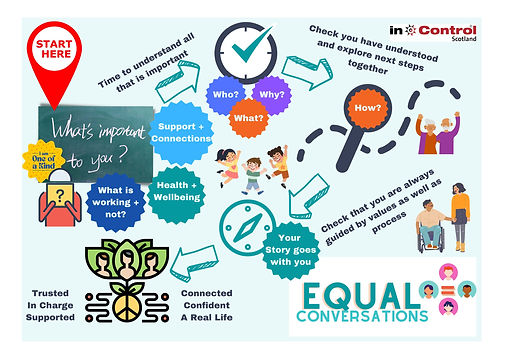
Why equal conversations?
There are a number of methods used to describe less task focussed, more strength-based discussions. You may have heard of these described as Good Conversations or the Three Conversation model. There are a lot of similarities in terms of what they aim to achieve. There is general agreement that too often organisations have prioritised a focus on efficiency (use of time through short targeted appointments, and checklist-based assessment to establish eligibility for services and quick service referrals as solutions to need).
People are used to working in environments where they list what is wrong (deficits) and asking for help to fix it. If we don’t prepare the person for this different approach, they may feel you are not taking them seriously. Because of eligibility criteria, many are not used to discussing other parts of their life, and may struggle to see the relevance. Changing the balance of these conversations is crucial to changing the dynamics of interactions, as well as flexibility, speed, quality and sustainability of what is agreed.
We need to rethink this mindset and reconnect with the importance of people feeling empowered, involved and understood, rather than being the passive recipient of a service. Many of us try to work in this way anyway, however if the expectations of how we work are not aligned to these principles, it can affect the effectiveness of individual workers and their confidence to approach these situations in the best way.
What is the focus?
Equal Conversations focus on –
-
Building a different relationship
-
Creating opportunities for trust and openness
-
A shift away from a transactional / service-based focus to a person centred one
-
Allows a semi structured framework to ensure that you get the information you need, in a way that is helpful and helps the person feel heard.
-
Creates links between values, process and culture to identify blockers and help shift them
-
Supporting creative practice within agreed limits so decisions are evidenced quickly and can demonstrate the real impact of the actions being planned
-
Greater trust and flexibility, resulting in less wasted resource due to having excess support in place (just in case)
What does it look and feel like?
It starts with an acknowledgement that getting answers is not the sole objective. If there is equality of power, then it is truly a two-way conversation. We suggest these conversations have the following features-
-
Set out in advance about hearing what is important to the person, rather than just what they need help with
-
Create an environment that provides the best chance for engagement
-
Minimise repetition
-
Engage with the person to explore what the things they bring up mean to them, what is most important?
-
Clarify your understanding
-
Don’t get drawn into “fixing”
-
Open up opportunities to explore wider areas of discussion
-
Check out together what you are going to do next and by when
-
Acknowledge the difficulties without getting drawn into positions
-
Create and maintain a trusting equal dialogue where service and resource feature, but is not the main focus of discussion
Our sessions help you work through examples of this approach in action, explores personal and organisational readiness, anxieties and what it would take to move to this approach. We help to bring people with you and demonstrate with the examples of what you are facing, the impact on confidence, trust, streamlining decision making and positive impact on challenges / complaints due to greater engagement and satisfaction.
We look forward to exploring this with you.

